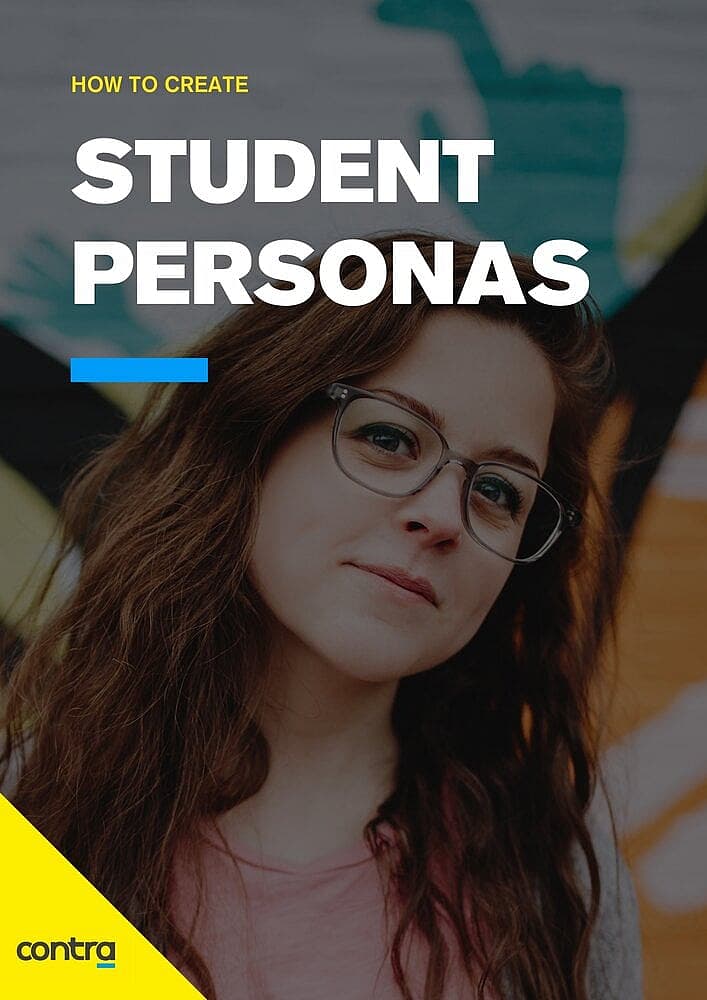University marketing strategy: How to create student personas.
10.09.2019
Student personas are the foundation of your university marketing strategy, enabling you to understand and focus on prospective students’ wants and needs.
In any purchase decision, there will be a long list of questions the buyer needs to answering before saying, “This is the one for me.”
In the case of students, some questions will be based on logical drivers (“Can I afford this?”, “What does the course involve?” etc.) and some will be based on emotional drivers (“What’s the nightlife like?”, “Will I easily be able to make new friends?” and so on). Buyer personas get to the bottom of these questions so your marketing efforts can appeal to these logical and emotional drivers.
Introduction to Student Personas.
Student personas are similar to buyer personas in the way you structure, research and plan content, but differ when it comes to the information gathered. How you use that information to generate interest among prospective students also differs. Whether your university is a specialist Art school or an Engineering institution, your organisation will benefit from creating personas to help boost student leads.
As we mentioned in our post on How to create buyer personas for your business, research is the most important step in understanding your audience and connecting with them on their level.
Research.
Irrespective of the information you have gathered in the past, it is always a worthwhile exercise to conduct further research on your target audience. You need to extract information about your target audience in a friendly way so people are more likely to help out. In a B2B environment, we would make it very clear that the call will not have a hidden sales agenda and we may also incentivise them to take part, the same goes for your university marketing. How could you get students to take part in your research? We have provided a number of options for getting people to take part in your research throughout this article.
There are 6 main areas you will need to gather information on. These are:
1. Education status: Are they a student or a parent? Are they an international or domestic student? Have they studied at University before? Are they an early admission or a clearing student?
2. Goals: Why is this degree important to them? What do they expect to achieve from their degree?
3. Challenges: What are they finding difficult about making their university decision? Are they well supported by family? How do you expect them to cope financially? Are they flush with choice or are they struggling to find what they’re looking for?
4. Resources: What does this person need to make an informed decision? Where does this person get information about universities? Who are their mentors?
5. Demographic background: What is this person’s background? What’s their family background? Where do they live? How old are they? Why are they interested in higher-education?
6. Decision-making: How do they make decisions? How long is their decision-making process? Do they care about campus tours? Do their parents have a say?
So, now that you know the 6 main categories for gathering your information, you need to start speaking to people. You want to gather information from multiple sources. You can speak to existing and prospective students, analyse your digital channels e.g. which blog posts get the most engagement, and conduct further online research.

Speaking to people
You can interview current students or survey prospective students. You can also reach out to your alumni for help, although you might need to raise the incentive bar. You may want to increase the number of international students who apply to the school. In that case, speak to some current international students about how they found out about your institution and why they chose your campus as their new home.
As with creating buyer personas for businesses you need to gather insight from multiple teams. Speaking to your Admissions Officers should be a great source of information. What do students ask most often? What do students love about your university? What do they dislike? What are some of the drivers that influence a decision on where to apply to university? For tips on how to ask for interviews, check out our comprehensive guide on how to create buyer personas.
Digital analysis
This is something you can do relatively quickly if you’re on top of your analytics. Here are some questions to get you thinking about how you can pull data from your website to inform your student personas.
- What pages get the most visits?
- What pages are people spending the most time on?
- What pages have high entry/exit rates?
- What pages get the most comments/highest engagement?
- What pages are driving your traffic?
- What content is not being consumed at all?
- What section of the FAQ page do people read most often?
If you’re using behavioural analysis tools like Hotjar in tandem with Google Analytics and alike, you’ll give yourself the best chance of understanding what people care most about.
Online research
Analysing your digital metrics will provide you with great data on the types of people already using your site, but what about those who aren’t? This is where some market research will come in handy to fill in the gaps. Read through other university blogs and look for the comments. Browse through social media using hashtags to uncover topics of discussion. Ask Google: “What do grammar school students look for in a university?”. Get creative at this stage. If you read the content being posted on the websites of similar universities (rank, size, location, courses, etc) then you’ll do more than discover what students care about, you’ll generate heaps of ideas for your own content strategy.
Using your research to create student personas.
Try to find patterns, trends and commonalities among the data you have collected. As you look for similarities remember to keep asking “why?”. They feel a certain way, or ask certain questions – why is this? The key to making successful Student Personas is to understand their motivations. When you have a number of personas, all with different but very clear motivations, you can create impactful content that speaks to their motivations and answers their questions before they even start seeking answers.
International students, domestic students and parents will all go to different places to find answers to their questions and conduct research about which university is best suited to them or their child. Early admission students and students who get a place through clearing will behave very differently and therefore require different messaging and content specifically targeted at them.
You might also want to think about creating negative personas at this stage. Learn more about negative personas here.
How to create your student personas.
Now that you have all the information you need, it’s time to put it all together and create your student personas. This will provide the foundation for your university marketing strategy. We created a free, easy-to-use tool to help you create your personas.
You do not need to go into a huge amount of detail in each section. Usually, 2-4 bullet points will do.
Assign your personas with a humanising name and profile picture. Help to capture the nature of your personas in the image and name you choose for them so they really stick. Naming the personas brings them to life and helps to embed the typical challenges you need to help them overcome.
We finished our personas. What’s next?
Marketing and admissions should use personas to direct their content and prospect nurturing strategies. Becoming super targeted with your recruitment efforts will ensure an efficient allocation of resources and should deliver greater returns from your marketing.
It’s likely you have many different personas, but which persona is your primary target? If you could only recruit one persona, who would it be? Once you have made this decision make sure you gear your content marketing strategy toward this person.
Do some keyword research using tools like Google Keyword Planner and Semrush to identify words and phrases that resonate with the search habits of this person, then go back to historic blogs and enter the relevant tags and keywords. Make sure you design your blog tags and labels around the terms they use moving forward.
Use the information you collect on topics that interest your personas, the language they use to talk about it, and where they spend most of their time talking about it (Twitter or forums etc) to create blog topics and headlines that resonate with them and encourage them to read.
Download persona template
Develop a more targeted Education marketing strategy. Begin building your student personas now with this free template.
Student Personas: The Free Template
Create your student personas and get more student leads. This resource includes:
- The demographic and psychographic info you need to consider
- Fully editable templates so you can customise the design
- Real-life student persona templates that we use for our clients in the Education sector


